The Capacity of a Muscle to Continue Contracting Over a Long Period of Time is Called
1
The different types of muscle tissue differ from each other by
a) microscopic anatomy.
b) location.
c) type of Control.
d) both microscopic anatomy and location.
e) All of these choices are correct.
2
Which of the following is NOT a major function of muscle tissue?
a) moving blood throughout the body
b) generating heat through contractions
c) stabilizing the movement of joints
d) promoting movement of body structures
e) production of vitamins.
3
Which property of muscle gives it the ability to stretch without damage?
a) electrical excitability
b) contractility
c) extensibility
d) elasticity
e) thermogenesis
4
In an isometric contraction the muscle develops tension but does not
a) lengthen.
b) widen.
c) does not expend energy.
d) conduct electrical current.
e) exhibit elasticity.
5
This is the outermost layer of connective tissue surrounding a skeletal muscle.
a) tendon
b) ligament
c) endomysium
d) epimysium
e) perimysium
6
What type of tendon is formed when the connective tissue elements of a skeletal muscle extend as a broad flat layer?
- a) perimysium
- b) deep fascia
- c) fascicle
- d) aponeurosis
- e) endomysium
7
After the fusion of myoblasts, the muscle fiber loses its ability to do what?
a) grow
b) lengthen
c) contract
d) go through cell division.
e) all of the answer choices
8
Which of the following correctly lists the sequence of structures that action potentials must move through to excite skeletal muscle contraction?
- a) sarcolemma, axon of neuron, T tubules
- b) T tubules, sarcolemma, myofilament
- c) muscle fiber, axon of neuron, myofibrils
- d) axon of neuron, sarcolemma, T tubules
e) myofibrils, myofilaments, mitochondria
9
The contractile organelles of a skeletal muscle fiber are thread-like structures called
a) myofibrils.
b) myoglobin.
c) mitochondria.
d) Z discs.
e) M lines.
10
Release of calcium from these structures triggers skeletal muscle contraction.
a) myofibrils
b) mitochondria
c) terminal cisterns of sarcoplasmic reticulum
d) T-tubules
e) none of the answer choices
11
Release of calcium from these structures triggers skeletal muscle contraction.
a) myofibrils
b) mitochondria
c) terminal cisterns of sarcoplasmic reticulum
d) T-tubules
e) none of the answer choices
12
Which of the following describe the regeneration capacity of cardiac muscle cells?
- a) limited, via satellite cells
- b) limited, under certain conditions
- c) considerable (compared with other muscle cells, but limited compared with epithelium), via pericytes
- d) all of these are correct
- e) none of these are correct
13
Which of the following regions of a sarcomere contain thin filaments?
a) I band
b) A band
c) H zone
d) Both I band and A band.
e) All of these answer choices are correct.
14
Which of the following regions of the sarcomere contain thick filaments?
- a) zone of overlap
- b) A band
- c) H zone
- d) both A band and H zone
e) All of these answer choices are correct
15
) Myofibrils contain
- a) contractile proteins.
- b) regulatory proteins.
- c) structural proteins.
- d) all of these answers are correct.
e) none of these answers are correct
16
Which of the following functions as a motor protein in all three types of muscle tissue?
- a) actin
- b) myosin
- c) troponin
- d) titin
- e) tropomyosin
17
What regulatory proteins can be found in the thin filaments of skeletal muscle fibers?
a) troponin and titin
b) tropomyosin and troponin
c) myosin and titin
d) titin and tropomyosin
e) tropomyosin and myosin
18
Which of the regions of a sarcomere contain titin?
a) the A band only
b) the H zone only
c) the zone of overlap only
d) from M line to Z disc
e) the I band only
19
Which of the following proteins is used to reinforce the sarcolemma and to help transmit the tension generated by the sarcomeres to the tendons?
- a) troponin
- b) tropomyosin
- c) myosin
- d) actin
- e) dystrophin
20
During muscle contraction by the sliding filament mechanism, thin filaments are pulled towards the
- a) Z disc.
- b) H zone.
- c) M line.
- d) A band.
- e) I band.
21
Calcium ions are released from the sarcoplasmic reticulum into the cytosol
- a) at the beginning of a contraction.
- b) in response to acetylcholine binding to Ca2+ release channels.
- c) by active transport using Ca2+ pumps in the SR membrane.
- d) after the contraction ends.
- e) All of these answers are correct.
22
What energizes the myosin head?
a) the actin filaments
b) calcium ions
c) potassium ions
d) ATP hydrolysis reaction
e) ADP synthesis
23
) Skeletal muscle contraction will continue to occur as long as the following chemicals are available in the cytosol of the muscle fiber.
a) ATP and acetylcholine (ACh)
b) calcium ions and ATP
c) ACh and potassium ions
d) sodium ions and ATP
e) calcium and ACh
24
To stimulate skeletal muscle contraction, acetylcholine must cross the _____ of the neuromuscular junction and bind to receptors on the motor endplate.
a) node of Ranvier
b) synaptic cleft
c) sarcolemma
d) synaptic end bulb
e) transverse tubule
25
Which of the following are commonly used to produce ATP during skeletal muscle contraction?
a) creatine phosphate
b) anaerobic cellular respiration
c) aerobic cellular respiration
d) All of these choices are correct.
e) None of these choices are correct.
26
In skeletal muscles, the combined amounts of creatine phosphate and ATP provide enough energy for the muscle to contract maximally for approximately
a) 15 seconds.
b) 15 minutes.
c) 1.5 minutes.
d) 5 seconds.
e) one minute.
27
Which of the following consists of a somatic motor neuron and all the skeletal muscle fibers it stimulates?
a) sarcomere
b) motor unit
c) neuromuscular junction
d) muscle unit
e) multi-unit smooth muscle
28
A brief contraction of all muscle fibers in a motor unit in response to a single action potential moving down the somatic motor neuron is known as
a) isometric contraction.
b) isotonic contraction.
c) tetany.
d) refractory period.
e) twitch contraction.
29
Which of the following is referred to as the period of lost excitability in skeletal muscle fibers?
a) refractory period
b) contraction period
c) latent period
d) relaxation period
e) wave summation
30
Increasing the number of active motor units within a skeletal muscle is called
a) wave summation.
b) fused tetanus.
c) motor unit recruitment.
d) muscle tone.
e) flaccidity.
31
This is the least powerful type of skeletal muscle fiber.
a) slow oxidative fiber
b) fast oxidative fiber
c) fast glycolytic fiber
d) slow glycolytic fiber
e) None of these choices.
32
Which of the following microscopic structures is only found in the cardiac muscle tissue?
- a) myosin
- b) tropomyosin
- c) sarcomeres
- d) intercalated discs
- e) striations
33
Which of the following types of muscle tissue contract when excited by their own autorhythmic muscle fibers?
a) cardiac muscle
b) slow twitch oxidative skeletal muscle
c) multi-unit smooth muscle
d) fast twitch glycolytic skeletal muscle
e) All of these choices are correct.
34
Smooth muscle tone is maintained by the prolonged presence of _____ in the muscle cell's cytosol?
a) ATP
b) calcium ions
c) phosphate ions
d) myoglobin
e) None of these choices.
35
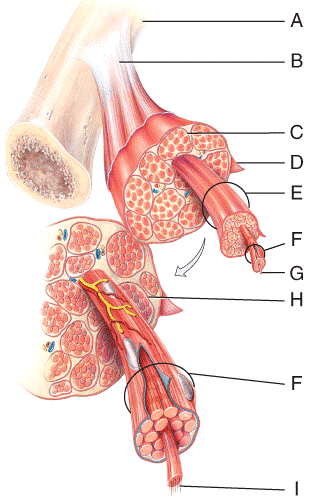
On the diagram, where is the outer most layer of connective tissue encircling the entire muscle
- a) A
- b) B
- c) C
- d) D
- e) E
36

Which of the labeled structures on the diagram holds muscles with similar functions together, allows free movement of muscles, carries nerves, blood vessels and lymphatic vessels, and fills spaces between muscles?
- a) A
- b) B
- c) E
- d) G
- e) H
37
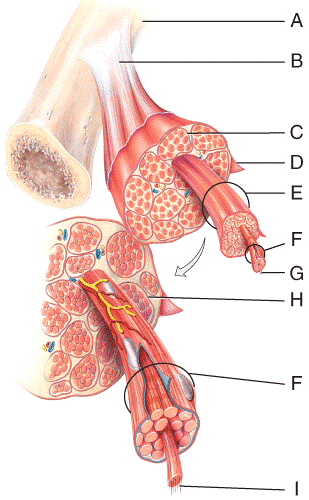
) In the diagram, a tendon is formed by the merging of the following structures
- a) C, D, and H
- b) D and E
- c) H and C
- d) C and D
- e) All of these choices are correct.
38
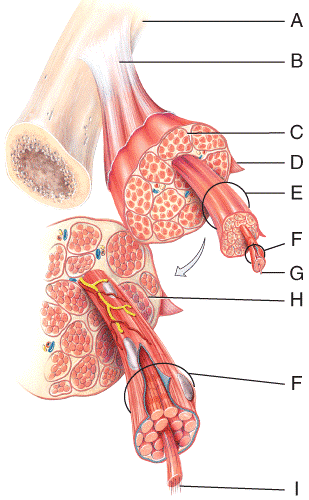
Which of the following structures are made of dense regular connective tissue?
- a) F
- b) A
- c) I
- d) Both F and I
- e) All of these choices.
39
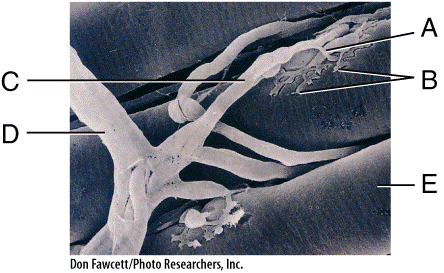
In the diagram, the neurotransmitter, acetylcholine, is released from this area.
- a) B
- b) C
- c) D
- d) G
- e) H
40
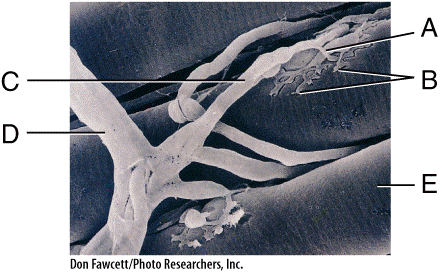
In the diagram, where is the axon terminal?
- a) A
- b) B
- c) C
- d) D
- e) E
41
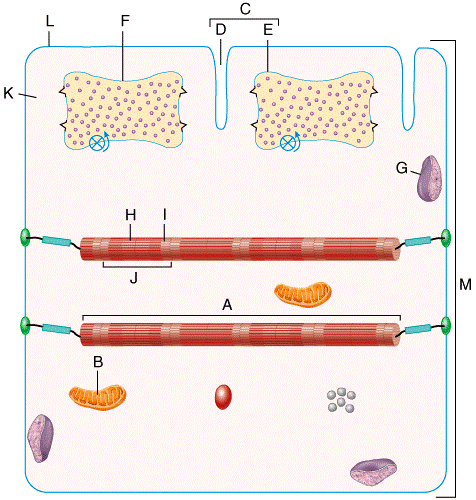
) In the diagram, where would you find stored Ca2+?
- a) B
- b) D
- c) G
- d) F
- e) K
42
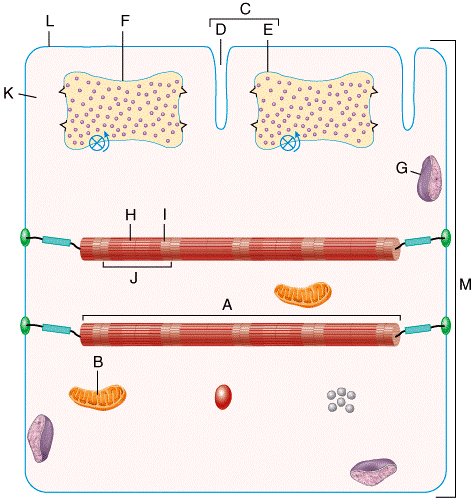
In the diagram, individual muscle fibers are covered by this layer.
- a) K
- b) I
- c) L
- d) M
- e) A
43
In the diagram, what is the basic functional unit of a myofibril?
- a) B
- b) C
- c) F
- d) Both B and C
- e) All of these choices are correct.
44
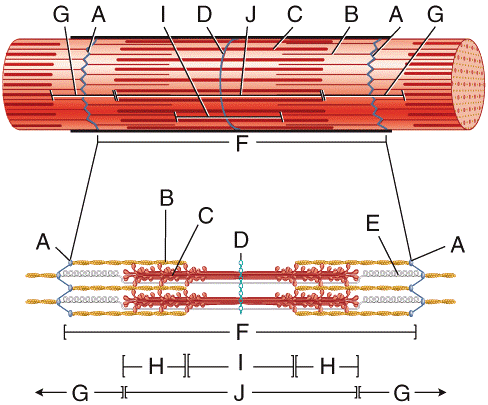
In the diagram, which structure helps return a stretched sarcomere to its resting length?
- a) B
- b) C
- c) E
- d) Both B and C
- e) All of these choices are correct.
45
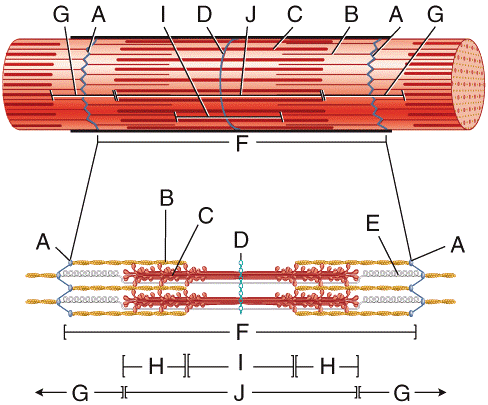
In the diagram, which labeled structure contains motor proteins that convert the energy in ATP into mechanical movements?
- a) C
- b) A
- c) E
- d) D
- e) None of these are correct.
46
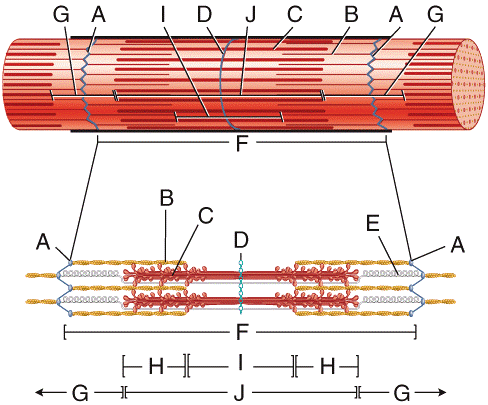
In the diagram, where is the I band?
- a) G
- b) H
- c) I
- d) J
- e) D
47
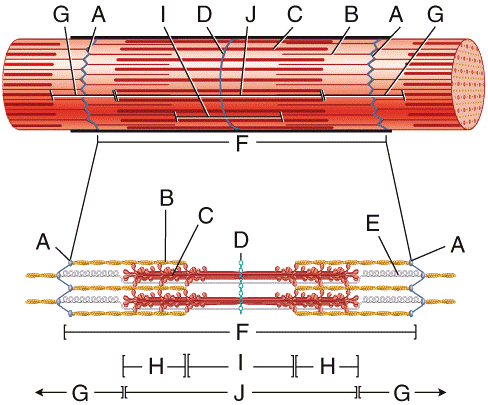
In the diagram, which structure(s) moves towards the center of the sarcomere (closer together) when the fiber contracts?
- a) A
- b) D
- c) J
- d) Both A and D.
- e) None of these are correct.
48
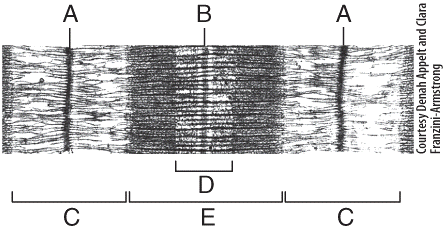
In the diagram, where are thick filaments found?
- a) C
- b) E
- c) A
- d) B
- e) All of these choices
49
Which of the following disorders is characterized by the wasting away of muscles due to the progressive loss of myofibrils?
a) muscular hypertrophy
b) muscular atrophy
c) fibromyalgia
d) myasthenia gravis
e) tremors
50
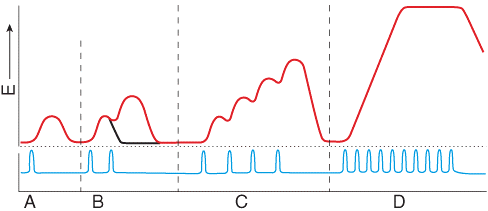
Which portion of this myogram shows a single twitch of the muscle?
- a) A
- b) B
- c) C
- d) D
e) none of these choices
51
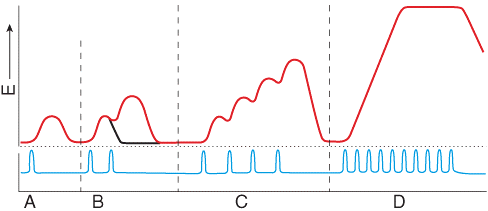
What is being shown by the axis labeled E?
- a) time
- b) tetanus
- c) force of contraction
- d) twitch factor
- e) wave summation
52
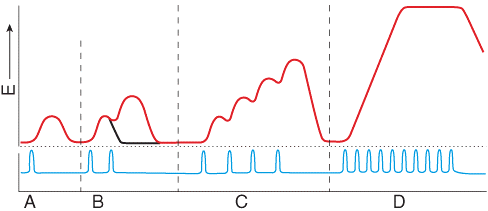
Which area of the myogram shows sustained contraction with partial relaxation?
- a) A
- b) B
- c) C
- d) D
- e) none of these choices
53
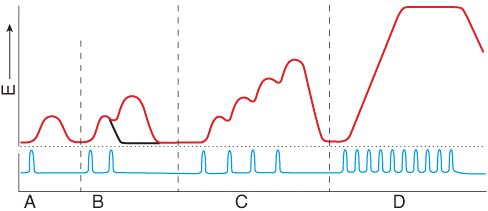
) Which area of the myogram shows a sustained contraction where individual twitches are indiscernible?
- a) A
- b) B
- c) C
- d) D
- e) none of these choices
54
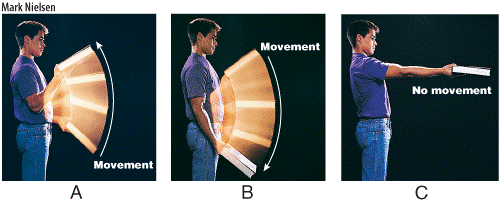
Which figure exhibits isometric contraction of the biceps brachii muscle?
- a) A
- b) B
- c) C
- d) none of these choices
55
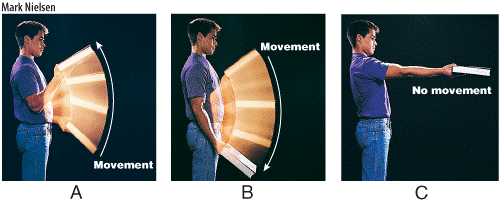
Which figure exhibits concentric contraction of the biceps brachii muscle?
- a) A
- b) B
- c) C
- d) none of these choices
56
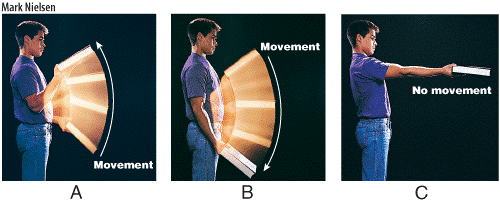
Which figure exhibits a contraction of the biceps brachii muscle in which its length increases?
- a) A
- b) B
- c) C
- d) none of these choices
57
Which is a NOT a side-effect of anabolic steroid use by male athletes?
a) sterility
b) baldness
c) diminished testosterone secretion
d) deepening of the voice
e) atrophy of testes
58
Which of the following types of abnormal contractions of skeletal muscle may be caused by holding a position for a prolonged period?
a) spasm
b) fasciculation
c) tremor
d) fibrillation
e) cramp
59
Which of the following is a common effect of aging on skeletal muscle?
a) loss of muscle mass
b) decrease in maximal strength
c) a slowing of muscle reflexes
d) loss of flexibility
e) all of these are correct
60
Which of the following statements does NOT accurately describe aerobic cellular respiration in skeletal muscles?
a) Pyruvic acid generated by glycolysis enters the mitochondria.
b) O2 is essential.
c) CO2 is produced as a waste product.
d) Lactic acid is continually produced.
e) Can be used to generate ATP from fats, proteins or carbohydrates.
61
After prolonged strenuous exercise has stopped, heavy breathing will often continue for several minutes in order to provide the oxygen needed to
a) convert the lactic acid produced during exercise back into glycogen.
b) resynthesize creatine phosphate.
c) replace oxygen displaced from muscle myoglobin.
d) All of these choices
e) None of these choices
62
Which of the following types of muscle tissue is capable of undergoing the stress-relaxation response when they are stretched?
a) cardiac muscle fibers
b) fast glycolytic fibers
c) fast oxidative-glycolytic fibers
d) slow oxidative fibers
e) single-unit smooth muscle fibers
63
Cross bridges are formed during muscle contraction when _____ on the thick filaments binds to _____ on the thin filaments.
- a) myosin; troponin
- b) myosin; troponin
- c) myosin; actin
- d) actin; myosin
- e) actin; tropomyosin
64
In a neuromuscular junction, the effect of acetylcholine (ACh) binding to receptors on the motor end plate lasts only briefly due to
a) rapid uptake of the ACh into the myofiber.
b) endocytosis of the ACh receptor into the myofiber.
c) rapid destruction of ACh in the synaptic cleft by acetylcholinesterase.
d) rapid destruction of ACh in the synaptic cleft by monoamine oxidase.
e) diffusion of the ACh out of the synaptic cleft.
65
During which period of a twitch contraction does the muscle action potential move along the sarcolemma of the muscle cell and trigger calcium release into the sarcoplasm?
a) latent period
b) contraction period
c) relaxation period
d) absolute refractory period
e) relative refractory period
66
Which of following is a common characteristic of fast glycolytic (FG) skeletal muscle fibers?
a) large amount of myoglobin.
b) many mitochondria.
c) low concentration of creatine kinase in the sarcoplasm.
d) slow myosin ATPase.
e) high amount of glycogen in the sarcoplasm.
67
Myasthenia Gravis is an autoimmune disorder that targets the ACh receptors at the NMJ and ultimately reduces the number of available receptors. Predict what happens if you treat the patient with a drug that inhibits the activity of acetylcholinesterase?
a) prevent contraction
b) weak contraction
c) normal contraction
d) cause spasm
e) none of these choices
68
Leg muscles are predominantly composed of which type of muscle fiber?
a) slow oxidative
b) fast glycolytic
c) fast oxidative-glycolytic
d) slow glycolytic
e) fast oxidative
Source: https://www.easynotecards.com/notecard_set/58669
0 Response to "The Capacity of a Muscle to Continue Contracting Over a Long Period of Time is Called"
Post a Comment